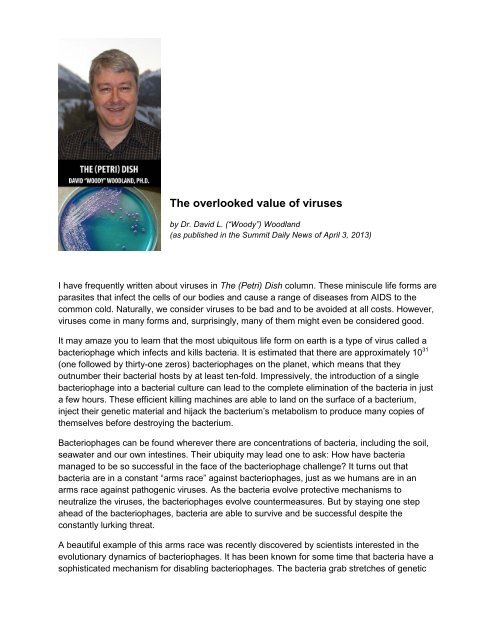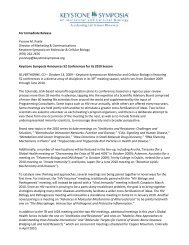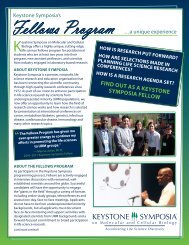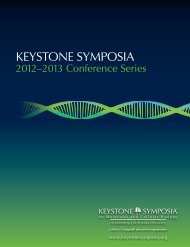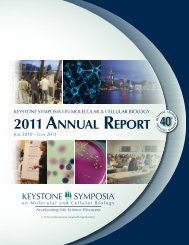The overlooked value of viruses - Keystone Symposia
The overlooked value of viruses - Keystone Symposia
The overlooked value of viruses - Keystone Symposia
Create successful ePaper yourself
Turn your PDF publications into a flip-book with our unique Google optimized e-Paper software.
<strong>The</strong> <strong>overlooked</strong> <strong>value</strong> <strong>of</strong> <strong>viruses</strong><br />
by Dr. David L. (“Woody”) Woodland<br />
(as published in the Summit Daily News <strong>of</strong> April 3, 2013)<br />
I have frequently written about <strong>viruses</strong> in <strong>The</strong> (Petri) Dish column. <strong>The</strong>se miniscule life forms are<br />
parasites that infect the cells <strong>of</strong> our bodies and cause a range <strong>of</strong> diseases from AIDS to the<br />
common cold. Naturally, we consider <strong>viruses</strong> to be bad and to be avoided at all costs. However,<br />
<strong>viruses</strong> come in many forms and, surprisingly, many <strong>of</strong> them might even be considered good.<br />
It may amaze you to learn that the most ubiquitous life form on earth is a type <strong>of</strong> virus called a<br />
bacteriophage which infects and kills bacteria. It is estimated that there are approximately 10 31<br />
(one followed by thirty-one zeros) bacteriophages on the planet, which means that they<br />
outnumber their bacterial hosts by at least ten-fold. Impressively, the introduction <strong>of</strong> a single<br />
bacteriophage into a bacterial culture can lead to the complete elimination <strong>of</strong> the bacteria in just<br />
a few hours. <strong>The</strong>se efficient killing machines are able to land on the surface <strong>of</strong> a bacterium,<br />
inject their genetic material and hijack the bacterium’s metabolism to produce many copies <strong>of</strong><br />
themselves before destroying the bacterium.<br />
Bacteriophages can be found wherever there are concentrations <strong>of</strong> bacteria, including the soil,<br />
seawater and our own intestines. <strong>The</strong>ir ubiquity may lead one to ask: How have bacteria<br />
managed to be so successful in the face <strong>of</strong> the bacteriophage challenge It turns out that<br />
bacteria are in a constant “arms race” against bacteriophages, just as we humans are in an<br />
arms race against pathogenic <strong>viruses</strong>. As the bacteria evolve protective mechanisms to<br />
neutralize the <strong>viruses</strong>, the bacteriophages evolve countermeasures. But by staying one step<br />
ahead <strong>of</strong> the bacteriophages, bacteria are able to survive and be successful despite the<br />
constantly lurking threat.<br />
A beautiful example <strong>of</strong> this arms race was recently discovered by scientists interested in the<br />
evolutionary dynamics <strong>of</strong> bacteriophages. It has been known for some time that bacteria have a<br />
sophisticated mechanism for disabling bacteriophages. <strong>The</strong> bacteria grab stretches <strong>of</strong> genetic
material from the infecting bacteriophage, make copies <strong>of</strong> it and then insert it into an enzyme<br />
complex designed to destroy genetic material. <strong>The</strong> captured genetic material then acts as a<br />
template to guide the enzyme complex onto the bacteriophage genes and destroy them. In<br />
other words, the bacteria use the bacteriophages’ own genetic material to target them with a<br />
gene-seeking missile. This is a highly sophisticated and efficient protective mechanism. But it<br />
has now emerged that some bacteriophages have hijacked the idea and developed a similar<br />
mechanism, one that is targeted against their bacterial hosts. In particular, it was found that<br />
bacteriophages which infect cholera-causing bacteria have acquired the technology to re-target<br />
the degrading enzyme complex back onto bacterial genes responsible for controlling the antiviral<br />
response. And so the race continues.<br />
<strong>The</strong> potent anti-bacterial activity <strong>of</strong> bacteriophages has naturally led scientists to consider using<br />
them as “natural” antibiotics. As early 1896, this idea arose when Ernest Hanbury Hankin<br />
observed that water from the Ganges and Yamuna rivers in India was active against the cholera<br />
bacteria. While those early attempts to use river water to cure disease were a little premature,<br />
modern science <strong>of</strong>fers tremendous hope for harnessing these <strong>viruses</strong> for good. It is important to<br />
note here that bacteriophages are not able to infect human cells since the physiologies <strong>of</strong><br />
bacterial and human cells are very different. <strong>The</strong>refore, bacteriophages would be very safe to<br />
use in a clinical setting. Indeed, bacteriophages <strong>of</strong>fer considerable hope in our own arms race<br />
against the bacterial world, especially as we begin to run out <strong>of</strong> antibiotics against some types <strong>of</strong><br />
pathogenic bacteria. In addition to clinical applications, bacteriophages have been used to<br />
control bacterial infections in a variety <strong>of</strong> food products, including meat and cheese, and they<br />
have been considered as potential antidotes to bio-terror weapons containing the bacteria that<br />
cause diseases such as anthrax.<br />
While the potential benefits <strong>of</strong> bacteriophages are many, there are some negative aspects.<br />
Biotechnology companies that rely on the mass culture <strong>of</strong> bacteria to produce products are<br />
frequently impacted by bacteriophage infections. Even the dairy fermentation industry is<br />
impacted, with bacteriophages causing significant problems in yogurt production. In an<br />
evolutionary war, it seems you can’t win them all.<br />
David L. “Woody” Woodland, Ph.D. is the Chief Scientific Officer <strong>of</strong> Silverthorne-based <strong>Keystone</strong><br />
<strong>Symposia</strong> on Molecular and Cellular Biology, a nonpr<strong>of</strong>it dedicated to accelerating life science discovery<br />
by convening internationally renowned research conferences in Summit County and worldwide. Woody<br />
can be reached at 970-262-1230 ext. 131 or woody@keystonesymposia.org.


